Covered aerated static pile composting system and pad installed at City of Napa’s MDF. The facility processes commercial (inset) and residential organics.
Nora Goldstein
Food waste recycling in the City of Napa, California dates back to 1920 when Napa Garbage Service (NGS) started a food scrap collection program utilizing the company’s herd of pigs. Today, the original company, part of a consortium of solid waste companies that owns Napa Recycling & Waste Services, continues to service the City of Napa with residential and commercial organics collection, as well as operates the city’s composting and recycling facilities. Food composting pilot programs began in 2006, with commercial and residential organics programs fully implemented by 2015.
The original composting facility, together with a materials recovery facility, were built in 1993 on land acquired by NGS — at that point the City of Napa’s franchised solid waste services provider — about 2 miles south of the city limits in Napa County. The city and NGS built the City of Napa Materials Diversion Facility (MDF) under a 50/50 equity share agreement. The agreement gave the City the right to purchase the facility.
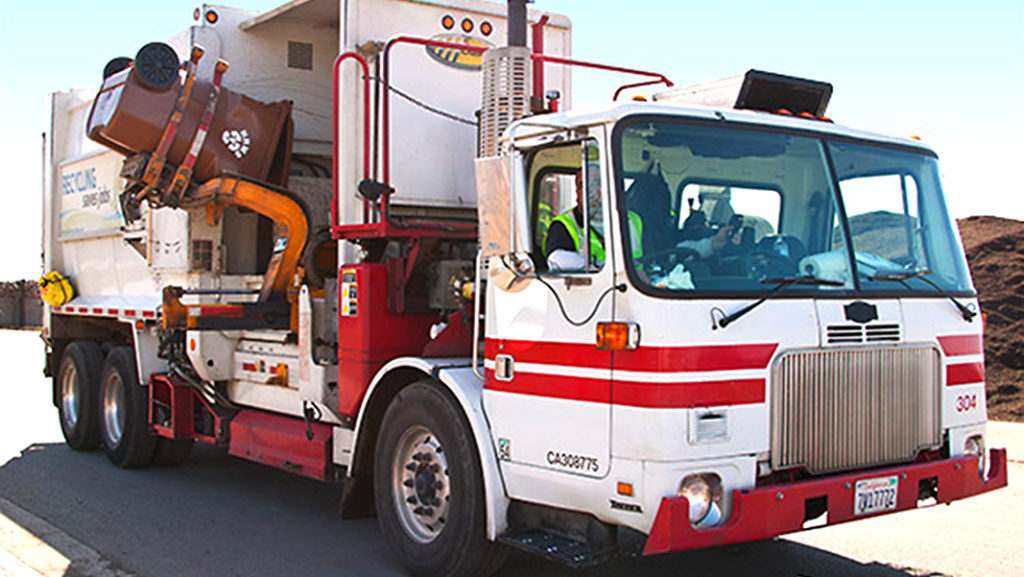
Truck tipping brown organics cart on residential collection route in City of Napa. All photos courtesy of Napa Recycling & Waste Services
In 1998, NGS sold its city of Napa waste services franchise to Waste Management. Then, in 2003, the city exercised its right to purchase the facility from Waste Management and issued a Request for Proposals in 2004 for two services: Collection of trash, curbside recycling and yard trimmings, and MDF processing services. Napa Recycling & Waste Services (NRWS) won the bid. Under the contract, NRWS operates the MDF, markets material, and provides education and outreach services. The city operates the MDF gatehouse and scale, and receives 70% of recyclable materials sales income and, under its most recent contract extension with NRWS (2018), 5% of compost sales income.
“The contract is a diversion-based franchise agreement,” explains Tim Dewey-Mattia, NRWS’ Recycling and Public Education Manager. “We are incentivized to divert recyclables and organics to the city-owned MDF, i.e. we get paid more to divert more tonnages to the city’s facility vs. sending it to landfill. The latter would cost the City of Napa more in transfer station tipping fees.”
Preprocessing, Composting Facility Upgrades
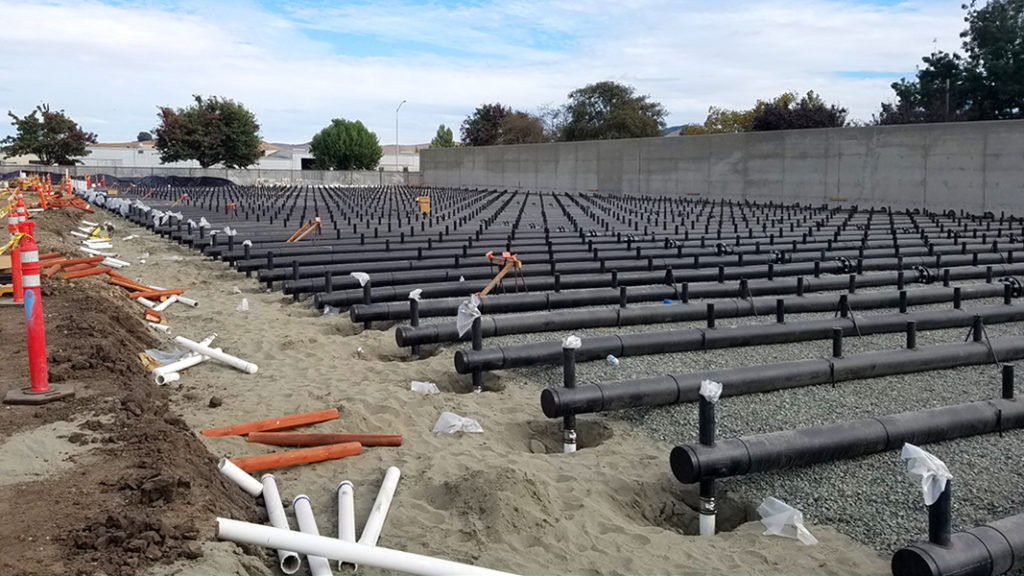
New CASP system, supplied by Engineered Compost Systems, has capacity to compost about 63,000 tons/year of material.
Food waste collected in the city of Napa is commingled with green waste in the organics cart. For many years, NRWS utilized windrows turned with front-end loaders to compost collected feedstocks. In anticipation of larger volumes of incoming organics due to state mandates to recycle food waste and yard trimmings and improve contaminant removal, the City of Napa approved a $10.4 million upgrade at its composting facility following a design-build solicitation issued in July 2017. Engineered Compost Systems (ECS) was awarded the contract to install a covered aerated static pile (CASP) composting system with capacity to process about 63,000 tons/year of source separated organics. The new CASP system started operating in January 2020. “The pipes are below the concrete floor which has 3,300 sparger nozzles,” explains Dewey-Mattia. “There is an exterior wall but no concrete dividers on the 2-acre active composting pad. The positively aerated piles are covered with a 12-inch compost cap during the active composting phase. Switching to an aerated static pile system increased our throughput capacity by about 20,000 tons/year.”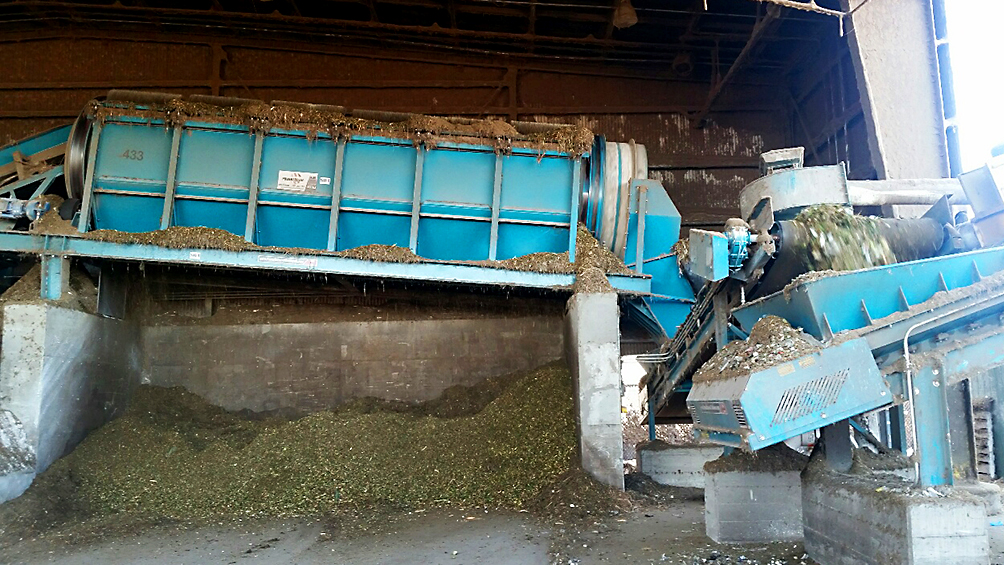
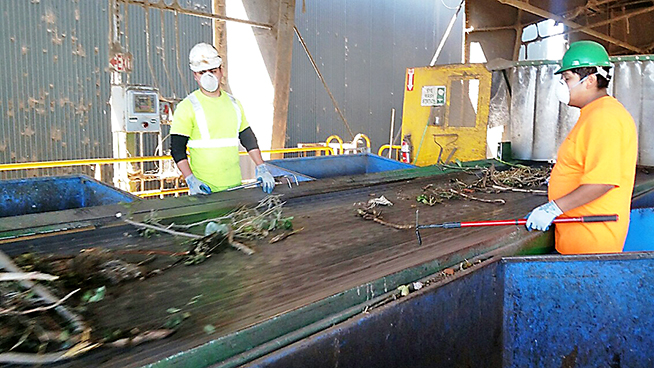
Residential organics are preprocessed at the MDF via a debris roller screen that feeds a sorting line. After grinding, feedstocks pass through a trommel screen (above) to remove remaining contaminants. Fines and overs are composted.
NRWS installed a preprocessing line from Bulk Handling Systems in 2016 for all incoming residential organics and material that is transferred there from other haulers. This stream first passes over debris roller screens to remove the fines, then onto a conveyor with 2 sorters who pull out plastic bags and other contaminants. Remaining materials are size-reduced in a Vermeer electric grinder and then screened in a trommel. Front-end loaders transport the processed organics to the CASP area.
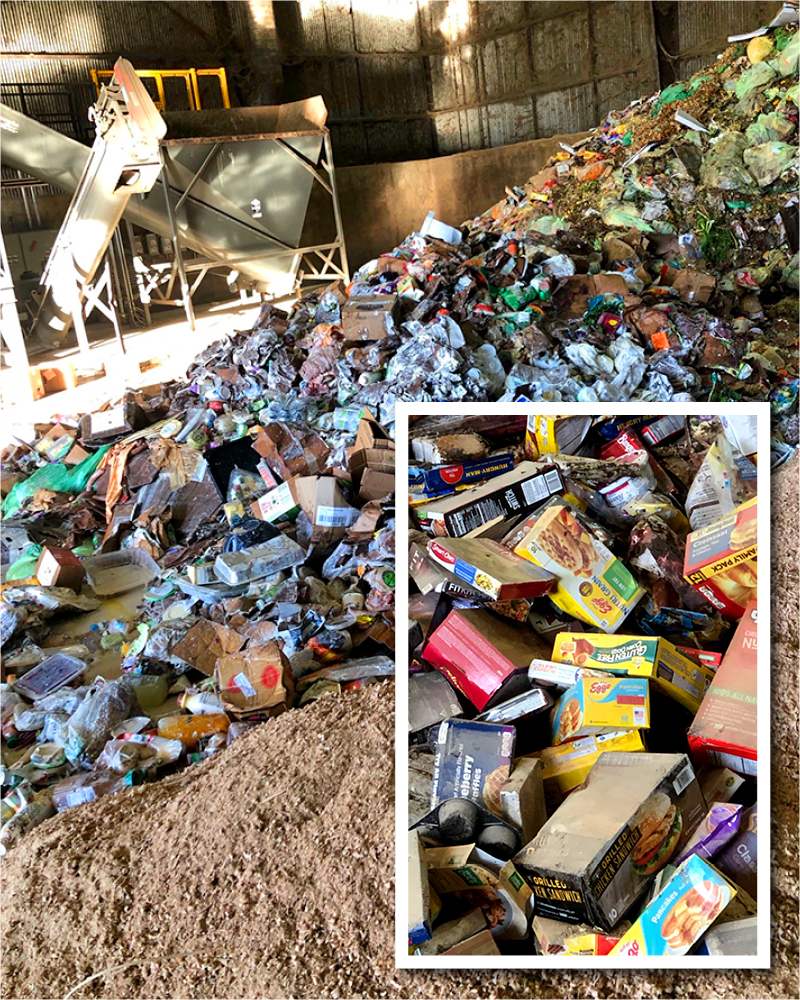
Commercial organics, including packaged food waste and food soiled cardboard, are loaded into a hopper that feeds a Scott Equipment THOR Turbo Separator. The slurry is mixed with sawdust (foreground) and taken to the CASP pad.
Another upgrade to the composting facility was installation of a Scott Equipment THOR depackaging system. The purchase was funded by a CalRecycle infrastructure grant. “We get a lot of packaged food from companies that have products they can’t sell,” says Dewey-Mattia. “We also use the Thor to process most of the commercial organics loads from our routes and other hauler’s routes. The slurry is mixed with sawdust from local wine barrel and box companies to help absorb excess moisture. It’s then mixed by the loader with green waste and transported via loader to the CASP area.”
He adds that 14,000 to 15,000 tons of food waste were composted in 2019. “It’s always been around 10% to 15% of incoming feedstocks. We also get 6,000 to 7,000 tons/year of grape pomace.”
In addition to processing organics from the city of Napa and unincorporated areas of Napa County, NRWS receives digestate from the BlueLine/South San Francisco Scavenger dry anaerobic digestion facility in South San Francisco, and commercial and residential organics from several other cities.
Air Quality Permitting, Markets
Getting through the air permitting for the composting facility expansion was “long and complicated,” notes Dewey-Mattia. “We are in the Bay Area Air Quality Management District (BAAQMD) and air permits for composting facilities are totally new to them. They didn’t have any baselines for VOC emissions for the controls we are using with the CASP, so NRWS became a test case for BAAQMD.”
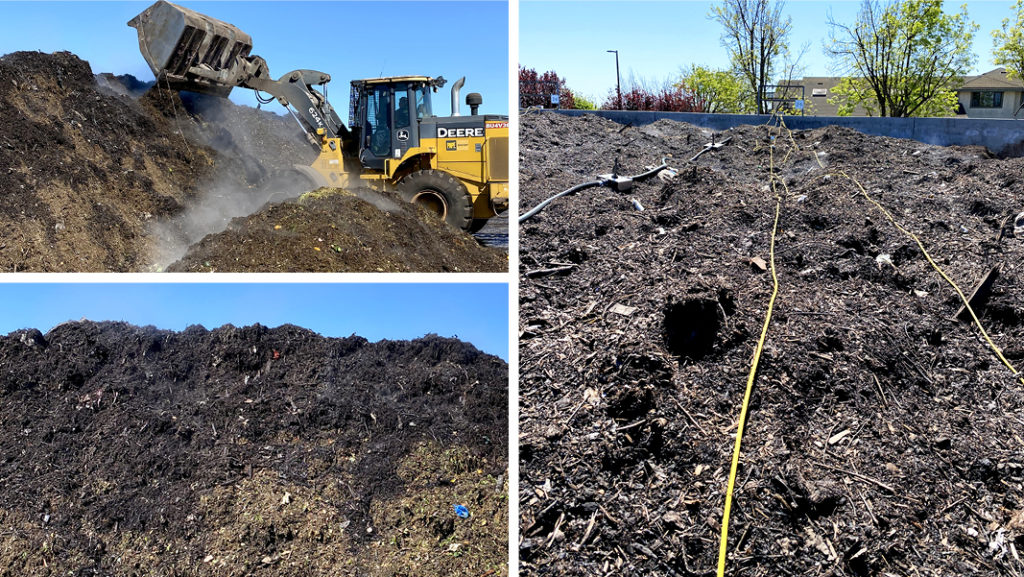
Under its air quality permit, NRWS covers active piles with a 12-inch compost cap (shown on left). Temperature probes and a hose with sprinkler attachments (right) aid in process control and provide data for required air quality monitoring.
The company has a full-time employee dedicated to meeting the permit requirements. All aspects of the composting facility must be monitored — feedstocks (e.g., green waste, wood chips, food waste), active composting and curing (until the compost is ready for sale), and process parameters such as temperature and moisture content. NRWS built a small lab for the testing out of a portable shipping container. “A goal of all of this testing and monitoring is to enable BAAQMD to come up with best practices,” he adds.
Active composting in the CASP is 22 days; curing is done on an open pad for a minimum of 40 days. Finished compost is screened using a Backers star screen that yields 3 fractions of end product. Much of the compost is sold in bulk to soil blenders. A significant portion is utilized for agriculture, e.g., on area vineyards and orchards, and for higher value crops like cannabis. “We have worked with the local soil conservation district and the Marin Carbon Project to explore ‘carbon farming’ to increase carbon sequestration in soils,” says Dewey-Mattia. “There is great potential, especially for using our products with more wood material on rangelands.”
Compostable Products
BPI-certified compostable liner bags (e.g., for countertop food waste containers and bins), along with BPI-certified compostable fiber products (e.g., cups, clamshells from restaurants) are accepted in the residential and commercial organics streams. Soiled paper, napkins and cardboard are also accepted, as are certified compostable cleaning wipes. The paper products tend to get pulped in the depackager because they are mixed with wet food waste and are part of the slurry. Other compostable packaging in the commercial stream is removed via depackaging.
NRWS’ compost is certified organic by OMRI (Organic Materials Review Institute), which makes it a challenge to accept all types of certified compostable food service packaging. However, a significant benefit of the new CASP process is the ability to make batches of compost with feedstocks that are not allowed in certified organic compost. “In addition to some compostable packaging, we also get a lot of sheet rock at the site that is not allowed in an OMRI-certified compost,” explains Dewey-Mattia. “We are starting to make a conventional compost product that includes the compostable packaging and the sheet rock. We don’t receive a lot of compostable products through the city of Napa organics collection routes. They mostly come from large events that are zero waste.”
He emphasizes that the two big roadblocks with certified compostable packaging are the organic certification and the lack of clear labeling. “It is not operational,” he says. “These products break down. That is not the issue. The clear labeling is for the consumer because once the products are in the bin, it is hard to distinguish them from conventional plastic packaging. That’s why we tend to prefer fiber-based certified compostable packaging.”
While operations at the composting and recycling facilities have not been impacted by the COVID-19 pandemic, one change that Dewey-Mattia has noted over the past six months is higher household participation in the residential organics collection program. “Our curbside organics collection tonnages are at record levels, though a lot of that has to do with an increase in yard trimmings as more people are home and doing yard work,” he says. “But people also are cooking more at home. We have not been able to quantify the increase in food waste yet but we do feel like the trend is positive for food composting participation.”













